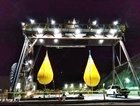Recommend
Remove File
Remove document <span id="remove-document-name"></span> from <span id="remove-cart-name"></span>?
Our motor-driven reel, cable festoon, and TrenchGuard systems power a large gantry crane that handles low-level pumping equipment. The pumping system aims to help Nevada compensate for reduced levels at Lake Mead, Hoover Dam.
Ace World Companies (Fort Worth, TX) brought Conductix-Wampfler in to be part of a massive undertaking to combat against the longstanding drought issue affecting Lake Mead.
In 2015, the Southern Nevada Water Authority began a $650 million project to construct a low-level pumping station to ensure water can still be fed to southern Nevada even if Hoover Dam is no longer able to. The pumping station is expected to be operational in 2020.
The project involves installing 22 low-lift pumps and 12 high-lift pumps that can pull up to 900 million gallons of water a day. The water comes from a 12,500 square-foot man made cavern, or forebay, 500 feet below the pumping station.
Ace World supplied their 220-ton gantry crane to handle piping and pumps. The crane has one main 220-ton hoist and two 30-ton auxiliary hoists, which are powered by four M line 0320-series I-beam festoons from Conductix-Wampfler.
Below the festoon, Conductix-Wampfler’s motor-driven cable reel provides runway power and feeds the cable into a trench protected by our Trenchguard system. The cable trench sits parallel to the crane’s rail track and protects the cable from vehicles, environmental conditions, and spillage.
The project called for the gantry crane to lower the pipe sections with the submersible pumps down each of the 34 vertical shafts. Each shaft is 500 feet deep and six feet across, which feeds directly into the forebay. The crane will remain in place should any of the pumps need to be retrieved for maintenance.

According to the Southern Nevada Water Authority, Lake Mead’s water levels have dropped more than 130 feet since the drought began in 2002. The two main pumping stations go down to 1,050 and 1,000 feet above sea level, respectively. At 875 feet above sea level, the low-level pumping station ensures southern Nevada still receives its water supply when Hoover Dam’s water level falls below 895 feet above sea level and is unable to discharge water downstream.